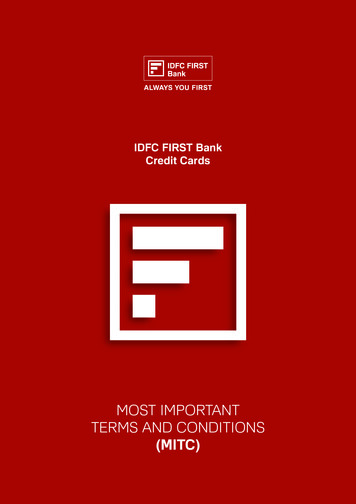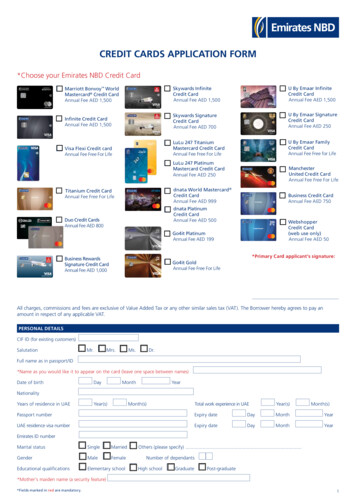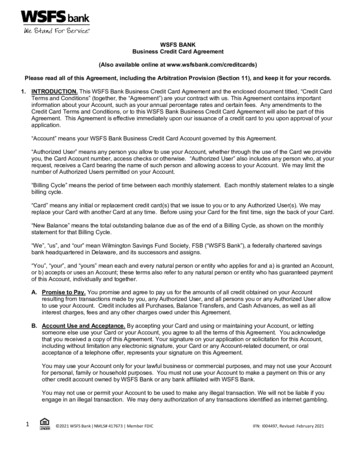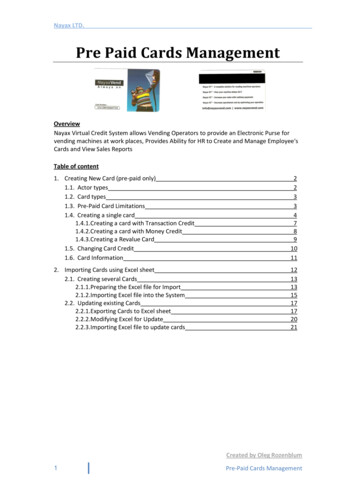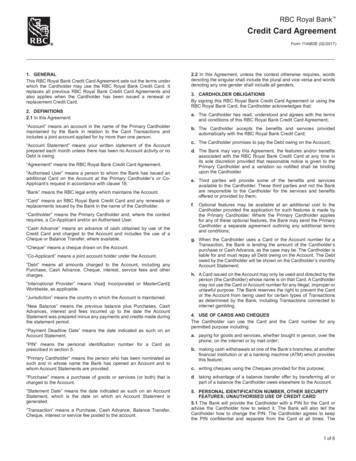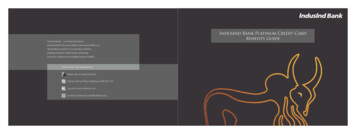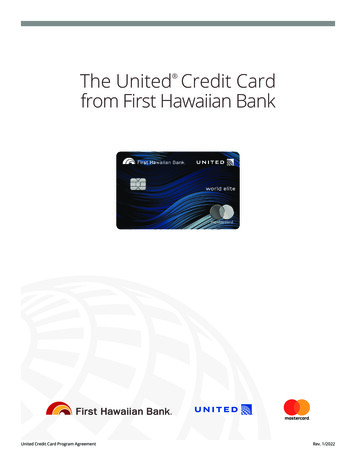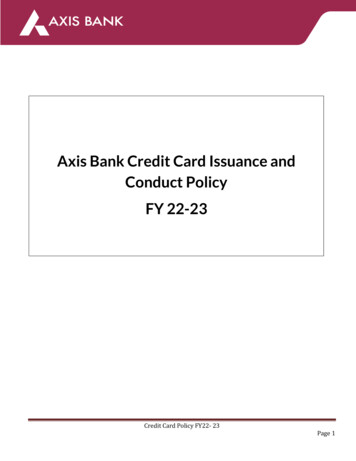
Transcription
Axis Bank Credit Card Issuance andConduct PolicyFY 22-23Credit Card Policy FY22- 23Page 1
Table of ContentsA. CREDIT CARD TYPES .3B. CREDIT CARD SALES .5C. CARD OPERATIONS .61.2.3.4.5.Underwriting . .6Operations . .6CPU (Central processing unit) Logistics .6Risk . . .7Default & Bureau Reporting . . .8D. OTHER BUSINESS FUNCTIONS . 8E. CUSTOMER SERVICE & GRIEVANCE REDRESSAL . . .10F. CREDIT CARD CHARGES AND TERMS . . .11Credit Card Policy FY22- 23Page 2
A. Credit Card Types:The Credit card business of the bank is operational since 2006-07. The types of cards issued by the bank are asfollows:1. Core Credit Cards: –These are cards issued to retail customers and vary from segment to segment. Theseinclude products like Platinum, Titanium and Signature credit cards. Bank also issues contactless creditcards to the customers from September 2015.Core credit card has following segments:a. Retail Credit card segmentb. Affluent Credit Card segment2. Co-branded Cards: Credit card which is jointly offered by Bank and other merchant/corporate is calledCo-branded cards. The Bank has defined a policy framework for co-branding on cards which is approvedby the Board and all changes/ modifications are covered as part of the Retail Lending & Payments Creditpolicy for the Bank.The existing tie up’s under Co-branding arrangement are as underCo-brand Credit Card PartnersLIC CardsMiles & MoreVistaraFreechargeFlipkartIndianOilGoogle PayAirtelSpiceJet The role of above cobrand partner falls under the following scope:oExtending their brand association/ loyalty for marketing of cobrand card to its user or loyaltybaseoPromotion and Marketing of the cobranded cardoLead Generation or application for the cobranded cardoProvide a touch point for customer service and direct cardholders to Bank for any card relatedservice/ grievancesBank follows a change management process for onboarding any new credit card partnership, includingreview of proposed partnership, partner due-diligence, financial evaluation, proposed product featuresCredit Card Policy FY22- 23Page 3
and processes, onboarding and customer service, technology and operations integration specific to thecobrand partnership. The Bank as part of due-diligence also validates if partner has all requiredregulatory approvals (if required) to enter into a co-brand partnership. The Bank as part of the co-brandarrangement may share revenue/fees with the partner.3. Commercial cards: The Commercial Card Payment solution is an effective way for corporates and theiremployees to manage their official expenses. Axis Bank's Commercial Card offers the travel, expenseand vendor management solution to corporates with global acceptance and customized solutions.Virtual cards are also issued to corporates which is a safe and secure way of making digital payments.There are two payment solutions offered to corporate clients under the commercial cards i.e.a. Corporate Card: used for travel expense reimbursement (including associated product variants).b. Purchase Card: used for vendor payments, utility, statutory payments (including associated productvariants)In order to augment business expansion, the commercial cards business may enter intoalliances/partnerships/co-brand arrangement and in such cases Commercial cards may be issued toindividual/sole proprietor entities.4. Secured Credit Cards: Issued to the individual against the Bank’s fixed deposits.a. Secured credit cards are issued to retail segment against the security of Bank’s fixed deposit to theextent of 80% of the value of the FD and lien is marked on the FD.b. Secured Commercial Credit Card: Secured Commercial Credit cards are issued to the corporatesagainst the security of our Bank’s Fixed Deposit to the extent of 90% of the value of the FD and Lienis marked on the FD in such cases. These limits are not subject to review on a periodical basis.5. Addon Credit Cards: Bank also issues addon/ supplementary credit cards upon request by the primarycardholders. Such cards are issued as per bank’s defined eligibility policy and liability for any outstandingon such cards is a responsibility of the primary card holder. These cards are issued post requisiteapplication, KYC and acceptance of terms and conditions by primary cardmember.The features, benefits and terms and conditions of Credit Cards that are offered by the bank are detailed onBank website. Product features and T&C are also communicated to customers at card onboarding and at varioustouch points such as welcome letters, welcome calling, billing statement post card issuance.B. Credit Card Sales:Bank sources credit cards via various channels, following is a brief on various sourcing platforms:1. Physical Sales: Currently bank sources application via various physical touch points including branches, coorigination with other banking products (such as salary accounts/ loans etc). For this channel, applicationsare initiated through hand held tablet/Mobile and sent for onward processing to Credit DIP and furthercredit decisioning is done in credit card onboarding system.Credit Card Policy FY22- 23Page 4
Commercial cards are sourced through Relationship managers located at respective sourcing locationsthrough Physical applications and further collection of requisite documents required for onboarding.2. Tele marketing: This includes sourcing via inbound and outbound call-centers, wherein application can becompleted real-time basis authentication for ETB customers or further shared with physical sales teamfor fulfillment.3. Digital Sales: This includes sourcing via Bank’s website, mobile application, Internet Banking platform.Bank also sourcing leads/ applications for credit cards via its cobranded partner platforms and otheraffiliates. Digitally sales applications are fulfilled by bank via digital KYC or further shared with physicalsales team for fulfillment.Other sourcing channels may also be used based on business requirement.With regards to customer segments, bank sources credit card across ETB and NTB segments across abovementioned sales channels and has various programs designed for the same.For ETB segment, bank runs multiple programs including pre-qualification of ETB customers. Such programshelp to deliver superior customer experience with straight through processing (STP) and also brings downcost of acquisition for credit card processing. Existing to Bank (ETB) customer can initiate the STPapplication themselves or assisted by Bank’s official on any of the bank channels. In case there is no addresschange and case is approved through automated credit decisioning, card gets setup in card managementsystem instantly.For NTB segment, Bank sources applications through multiple physical and digital channels. For physical channel, such applications are sourced via tablet-based application and furtherprocessed post credit and policy checks. For digital channels, customers are in-principally approved basis their application form submissionand thereafter customer is directed to Video KYC (VKYC) process which includes Aadhar OTP basedverification, video call with the bank agent and concurrent audit by bank official. Such end to EndDigital Journey with simplified application journey helps with improved TAT, enhanced customerexperience & improved sales efficiencies.In case of non-STP cases for ETB/ NTB, leads are sent to the physical sales team for fulfillment and furtherprocessing. Sourcing of Physical paper-based applications has been discontinued across all channels for Retailcredit cards.C. Credit Card Operations:1. Underwriting:a. Retail credit cards: Bank has a centralized underwriting team that handles card applications sourcedacross locations. All credit card applications undergo automated checks on onboarding system whichreviews application on multiple criteria including credit decision rules, bureau profile, NSDL validation,de-dupe against existing cardholders/ negative list, KYC match etc. Basis such checks, applicationsmeeting all criteria are auto-decisioned in system and routed for straight-through processing andCredit Card Policy FY22- 23Page 5
remaining are routed for DIP/ Underwriting checks. The decisioned cases are approved by theunderwriting staff as per delegation on the decision systems.This comprises of a) Credit DIP team which reviews applications for KYC and other application levelchecks basis which the application is approved for further processing or marked for rework/ review. B)Credit Underwriting team that validates other credit checks such as de-dupe, negative list match, fieldinvestigation etc.b. Commercial Cards - Commercial cards are being handled by a separate team under Pre-issuance verticaland the processing is done manually at NPC(1) for existing Axis Bank lending relationship customers aswell for customers without any Axis Bank lending relationships .Details including repayment behaviorof existing Fund and Non Fund Based lines issued to corporates by the Corporate Banking team areobtained and incorporated as part of the Commercial Card Proposal. In case of NTB Customers ieBorrowers with no other Axis Bank relationships, the facility is extended only with proper due diligenceand applying all credit filters as per the onboarding norms. In all instances, requisite approval is takenprior to limit sanctioning. The delegation of powers for commercial cards issuance is as outlined in theCorporate Card Policy of the Bank.2. Credit Card Operations:Various activities undertaken by the operations team are as follows:a. Repayments: Involves processing of card repayments.b. Financial services: Involves processing of requests such as providing EMI facility on cards, Balancetransfer facility, Credit Card insurance, Processing of Instant Loans on credit cards, Reversal ofCharges and Credit Card cancellation.c. Maintenance services: Involves processing of issuance of Add-on card, setting up of Auto debit forrepayment, Credit card replacement, Blocking & Activation of Cards, Customer ID linking, Cardsupgrade etc.d. MIS and Customer Service: Involves MIS maintenance and Customer Service.e. Proactive recoveries and recoveries requested by Collections3. CPU (Central processing unit) Logistics:Following activities are undertaken by the CPU team:a. Welcome kit Dispatch: Welcome kits with card plastic and welcome letter detailing productfeatures, terms and conditions and other collaterals are dispatched through courier. Printing ofcards and PINS, Statement printing/Email statements dispatching to the customers.b. Returned to Origin (RTO): Credit cards dispatched to the customers along with the Welcome letter,if undelivered, are returned back to the CPU - RTO team. The RTO management involvesAcceptance of RTO, Blocking of Cards, updating the reason for RTO, Tele calling & SMS tocustomers, noting the address change if any, re-dispatch, Reconciliation and destruction of such RTOcards and welcome letters.Credit Card Policy FY22- 23Page 6
4. Risk Team: The Risk team manages the risk for all Credit card products and their activities broadly includethe following:a.b.c.d.e.f.Policy formulation for customer onboarding and portfolio managementApproving changes to credit parametersDefining cut off scores.Approval of pre- approved schemes.Analyzing individual portfolios through data analytics.Providing early warning signals to the business based on portfolio trends.The 'Credit Guidelines for Issuance of Credit Cards and Portfolio Programs’ includes, inter alia,various individual programs likei.Card Issuance Policyii.Credit Limit assignmentiii.Instant Loan OTL (Over the limit)iv.Instant Loan WTL (Within limit)v.CLI (Credit Line increase)vi.CLD (Credit Line decrease)vii.OVL (Over limit padding)viii.BOE (Balance on EMI)ix.Cash limit reductionx.Upgradexi.DC EMI (Debit card EMI) etc.These are essentially customer onboarding and portfolio programs defined by the Risk/Policy team and coversvarious aspects relating to pre-qualified Base identification, limit ascertaining criteria, etc.All portfolio programs including credit limit assignment include assessment of customer’s profile and credithistory as available basis self-declaration or information obtained from credit information companies,customer’s card behavior including spends and repayments etc. Credit Limit and Cash Limit for all credit cardaccounts are decided basis the bank’s policy and are at sole discretion of the bank.The portfolio programs as well as subsequent changes to these programs are approved by the respectiveofficials/members as defined in the Bank’s Retail Lending and Payments Credit policy.The 'Credit guidelines for Issuance of Credit Cards and Portfolio Program's policy is reviewed on yearly basis.In accordance with the approval so provided by the prescribed officials/members, the activities, under therespective individual programs, are carried out on regular basis.5. Default & Bureau Reporting:Default and bureau reporting is done by the Risk Analytics teams in accordance with following guidelines:a. In the event of a default i.e. if the Minimum Amount Due is not paid by the Payment Due Date or breachof any clause of the Card Member Agreement, the Cardholder will be sent reminders from time to timeby post, telephone, e-mail, SMS messaging and / or through third parties appointed for collecting theCredit Card Policy FY22- 23Page 7
dues. Any third party so appointed, shall adhere to the Indian Bank's Association (IBA) code of debtcollection.b. In the event that the Cardholder commits an instance of default, the Bank at its sole discretion, will beentitled to:o Withdraw all Credit Card facilities to the Cardholder.o Ask the Cardholder to immediately pay all outstanding balance on his Card.o Exercise the Bank’s right to lien and set - off the amount outstanding against any monies /deposits / accounts maintained in the Cardholder name with the Bank.c. In the case of a default, the Bank can forward the default report to the Credit Information Bureaus or tosuch other agencies as approved by law. The time period between the Payment Due Date and the billingdate indicated on the billing statement is considered as the notice period for reporting a Cardholder asa defaulter.d. In case the cardholder settles the dues after being reported as defaulter, the Bank shall update the statusto Bureaus within 30 days from date of settlement of dues.The Bank submits the Cardholder's data to Credit Information Companies (“CIC”, namely TransUnion CIBILLimited, Experian Credit Information Co., Equifax Credit Information Serviced Pvt. Ltd., CRIF High Mark CreditInformation Services Pvt. Ltd.), every month in the format prescribed by them. This data includes the repaymentstatus of all Cardholders, both defaulters and current, for the previous month.D. Other Business functions:The sales, credit and operation structure for credit cards is supported by the following teams:1. Product Team: Responsible for Designing & implementing the product strategy including launch of new products and features anddriving customer engagement on product featuresDelivering the operating plan: achievement of growth objectives including market share, revenue, profitand return on investment for business.Managing co-brand card relationships & enter into new partnershipsManaging the customer communication to ensure superior experience.Ensuring adherence to all regulatory and compliance requirements.Work along with Business support group for driving new concepts, design, and implementation of variousIT & non-IT projects.2. Portfolio Team: Responsible for profitable book build by activating customers, deepening their engagementwith relevant cross-sell/spend linked offers, managing the exposures assigned to the customer and gatingpotential attrition. These actions are undertaken through varied pre-approved offers, analytically drivenengagement programs, design of experiments to test new segments/pricing, channel management andmaximizing the P&L of the portfolio with strong risk return framework.Below are the key programs managed by the Portfolio Team Drive card activation through welcome calling, activation calling and first impression campaignsCredit Card Policy FY22- 23Page 8
Drive installment balance book to manage portfolio risk by cross-selling EMI at purchase, EMI postpurchase and Instant Loan programs on cards. These are multi-channel programs and discipline ismaintained to reduce cost of acquisition, enhance digital penetration, right pricing and manage customercommunication/post-sell service issues. Several EMI alliance offers are run basis spends seasonality totake the best-in-class product experience to the customers. Managing proactive and reactive credit limit increase through multi-channel end to end STP journeys Provide the customer life-stage linked card experience using Credit Card Upgrade program so that AxisCard continues to be the first-in-wallet with his changing needs Continued engagement with customers with competitive spend offers through ATL(Above the line) andBTL(Below the line) campaigns, established properties like End of Season Sale/DiningDelights/Wednesday Delights. This helps us maintain industry rank in card spends Cross-sell the right value-added service to the customers which they can benefit from to enhanceprotection on cards (CPP) and avail health insurance services Credit Line decrease: Risk based interventions to right-size customers credit limit Over-limit Padding: To provide seamless payment experience, risk based temporary over limit pad is madeavailable to selected segments of customers. The portfolio programs are offered to eligible customers via multi channels, both digital- (MobileApp/Internet banking) & tele (inbound/outbound) with STP and NSTP capability. Eligibility for eachprogram is defined by multi variant risk strategy, using attributes basis customer’s banking, bureau &behavior on card accounts as applicable. Pacing check applicable cross product & intra-product ensureslimited exposure on similar lines of credit and any future eligibility is arrived basis credit performance onexisting obligations.3. Other Credit Card functions:a. Business Intelligence Unit: Generation of Apps Score for Credit cards and credit card limits using Blazesoftware and sending the same along with CIBIL score to Credit Card Team and decisioning on whetherFI to be done or not based on policy guidelines.b. Fraud Control Unit: Field investigation to be done at pre-sanction as well as at post sanction stage (eg.change of address, etc), dedupe of credit card applications through ‘Hunter’ software.c. Digital Transaction Monitoring (DTM): Daily monitoring of credit and debit card transactions from fraudperspective and carrying out investigations in suspected frauds.d. Authorization Team: Handling credit card and debit card transactions related queries; which receivethrough various channels (eg. activating cards for internet transactions, Credit Limit enhancement/OTBrectifications, change of customer demographic details, etc.e. Collections: Follow up with delinquent customers and collection of outstanding duesf.Customer Service: Handling inbound /outbound tele-calls / emails regarding service requests /complaints and raising the same in i-leverage, few other maintenance activities (eg. blocking of cards,reward point redemption, change of customer details, etc.)g. Business Solution Group (BSG): Bridge between Business and IT team for various IT level developments.Credit Card Policy FY22- 23Page 9
h. Credit Card IT: Overall maintenance of Prime including master template creation / updation for creditcard products, uploading / downloading of important files in Prime, Updation of health-code/ assetclassification of the borrower in CTL Prime from the centralized NPA stamping system in the Bank andfurther blocking credit card (Retail & Corporate) usage of NPA customers.i.Card Customer experience: Responsible for monitoring customer touch points for enhancingexperience.j.CRS: Reconciliation of card pool / office accounts.E. Customer Service & Grievance Redressal:Credit Card customer service and grievance redressal process follows the overall retail banking grievanceredressal policy that is approved by the customer service committee of the Board. The Bank also has a boardapproved compensation framework for retail banking services which includes credit cards. These policies coverin detail the channels available for the customers to report grievance, turn-around time, response timeline andcompensation for various categories of grievances.Grievance redressal mechanism including the escalation matrix is communicated to the customers via varioustouchpoints including bank website and billing statement.Following process is followed for specific scenarios as defined below:1. Closure of Credit Cards:Credit card customers can request for closure of credit card on voluntary basis via multiple servicechannels. Bank has a retention process whereby customers are contacted upon such request tounderstand the concern and offer a resolution, if available. In case no resolution is possible, suchrequests are taken ahead for closure of the card within 7 working days from date of receipt of closurerequest, subject to clearance of all outstanding dues by the customer, failing which Bank will be liable topay compensation as per RBI guidelines.Bank may also initiate closure of credit cards in case the cardholder is in violation of any of the cardmember terms and conditions agreed at the time of issuance or as duly notified by the bank from time totime. Cardholder would be intimated upon card closure in such cases and shall be liable for clearingoutstanding balance. Bank may also initiate closure of the cards upon sustained inactivity, post sufficientmeasures for engaging with the customer for card activation and with prior intimation.In case of any credit balance in the card account, bank transfers such balance to customer’s linkedsavings account (if any) or requests the customer for updation of bank account to initiate credit.2. Loss / Theft / Misuse of Cards:a. Customer must notify the Bank immediately via IVR if the Card is lost, stolen, if someone elseknows your PIN or other security information or if it being used without your permission.b. Card will be immediately blocked on intimation from the customer. Customer may also block andreplace card via Internet Banking/Mobile Banking.Credit Card Policy FY22- 23Page 10
c. Unauthorized transactions: Axis Bank’s Customer protection Policy has been formulated in linewith regulator guidelines on Customer Protection – Limiting Liability of Customers inunauthorized Electronic Banking Transactions. Policy outlines the framework for addressing &handling customer grievances related to unauthorized transactions to their accounts /cards andthe criteria for determining the customer liability in these circumstances. The policy can beaccessedthroughAxisBankwebsite.F. Credit Card Charges & TermsBank has ensured multiple processes to ensure transparency of charges to the customers. 1.One-page fact sheet containing important information regarding charges on credit card is provided atthe time of card applicationMost important Terms & Conditions (MITC) including Illustrative examples for computation of chargesand balance is displayed to/ shared with the customer at various stages in card lifecycle including cardapplication, welcome letter and regularly via billing statements. Same is also available on bank’s website.Computation of Finance / Interest Charges:a. The interest charges levied by the bank are visible to customers at axisbank.com and MITC.Detailed illustrations on interest charge calculation is explained in Axis Bank MITC. Anychanges in interest charges are duly notified to customers.b. The interest rates are guided by the instructions on interest rate on advances issued by theReserve Bank as amended from time to time, along with the Net Interest Margin of Credit CardBase (Interest levied on revolver base viz a viz Cost of Funds on entire base) and expected defaultrisk of revolver base. Currently the Bank charges interest rates between 1.5% per month(19.56% per annum) and 3.6% per month (52.86% per annum). Interest rates may be differentbetween different credit card variants, but same for all customers of a credit card variant.c. Interest will be charged;i.If the Total Amount Due is not paid by the Payment Due Date, interest will be charged onthe Total Amount Due and on all new transactions (from the transaction date) till such timeas the previous outstanding amounts are paid in fullii.On all cash advances from the date of the withdrawal until the date of paymentCredit Card Policy FY22- 23Page 11
Credit Card Policy FY22- 23 Page 3 A. Credit Card Types: The Credit card business of the bank is operational since 2006-07. The types of cards issued by the bank are as follows: 1. Core Credit Cards: -These are cards issued to retail customers and vary from segment to segment. These
